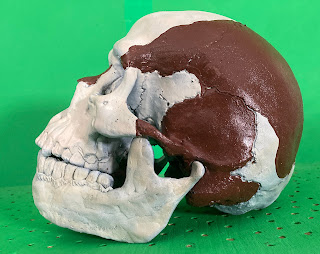Paleontology has a long and checkered history, with lots of mistakes and false assumptions littering its legacy. Among the more amusing ones is the story of the Piltdown Man.
The finished Piltdown Men (just one shown here) were augmented with dashes of acrylic paint, and of course, a handsome coat of bodily hair. The hair used was crepé hair (sheep's wool) glued on using liquid latex. Teeth were made from tissue paper and latex. The Cricket bat was cut from a strip of wood painted with watercolors.
The skull was then spray-painted with two layers of car paint and touched up with acrylic airbrush paints. The brown parts are a water-based hobby paint applied with a brush. They signify the actual fossil parts found.
Isn't this a cool picture? Jobin's Stegosaurus is taking in the sights in a (then) modern city to show the scale of the animal. All it reminds me of is, of course, modern Kaiju movies. This critter would certainly make a very nice stop-motion puppet.
My favorite movie dinosaur of all time is the 1933 "King Kong" Stegosaurus, built by Marcel Delgado and based on paintings of the animal made by Charles Knight. However you look at it I stole his designs or was inspired by them when sculpting my Victorian Stegosaur head. I also created a sculpture of knobbly, scaly skin similar to the hide on Delgado's monster. My head sculpture was quite small, just a bit over an inch and a half long, but I still managed to pack quite a bit of detail in there. The eyes are tiny doll's eyes and made by a seller on eBay, where I bought them years ago.
That knobbly skin is being applied, using liquid latex as a glue. I really like a good texture on a puppet. It monumentally adds to the character.
Here's the whole puppet covered with skin, cast with tinted latex in a texture mold from my skin sculpture.
The finished puppet is dry-brushed with tinted latex, with various subtle colors in layer over layer. The plates are bits of EVA foam covered with cotton and latex. The spikes are tissue paper and latex. The tiny teeth are just drops of latex tinted white. Small bits of latex skin were also attached to the edges of the mouth. I don't know if dinosaurs had that, but I've seen it in alligators and various lizards. The puppet is about 17 inches from the tip of the snout to the tip of the tail.
The second animal I chose to inhabit this undefined era-Britain was an incorrectly reconstructed Uintatherium; a herbivore described by American paleontologist Edward Drinker Cope (bitter enemy of Charles Othniel Marsh, by the way.) Cope called his animal Loxolophodon, and figured it was something like a small elephant or tapir with antlers, for some reason. The correct version of this animal (as far as we know) was provided by Marsh, and the genus Uintatherium was coined by Marsh's colleague Joseph Leidy. Anyway, Cope's reconstruction cried out to be animated, and so it was.
I wanted to add a few examples of prehistoric fauna to my caveman epic and felt that these animals ought to be on par with the Piltdown Man. Today we all know what a Stegosaurus looks like, but back when the original fossils were found several ideas were floating around. The above illustration is the creation of French artist Auguste-Michel Jobin and dates to 1884. Not only have the spikes and plates switched places, but the animal is now a biped. Eventually, American paleontologist Charles Othniel Marsh would figure out what the animal looked like, and with slight corrections, his version is what we still go with today.
Lots of soft polyurethane foam muscles were glued over the armature using flexible contact cement. I used a speculative reconstruction of dinosaur muscles as a guide.
Of course, this film was the perfect opportunity to finally do a Ray Harryhausen-inspired battle between two prehistoric beasties. Harryhausen's monster fights are quite similar, with certain tropes lovingly repeated, like an actor knowing what his audience wants and giving it to them: The circling combatants before the fight, the biting of horns, the foot on the fallen opponent -I included all of it in my animation. The only difference is that this fight is a draw. The monsters back off and live to fight another day.
A word about the backgrounds. I picked up a bunch of photos of the Hoh rainforest in Washington state, found on the Depositphotos collection, to which I subscribe. I felt that the drooping mosses and the glowing greens could represent a lush prehistoric England. The various marked-out walkways were removed in Photoshop.
The exploding volcano is a bit of stock CGI animation found on Videohive.com.
To research the animation for the Cricket play I actually watched actor Peter Davison perform a perfect bowl in the Doctor Who episode "Black Orchid."
The end credits are adorned by a rendition of Gilbert and Sullivan's "He Is An Englishman", sung by Harry Dearth in a 1907 recording. It's the only public domain recording I could find, but the crackling, ancient sound sort of fits in with the rest of the film.
.jpeg)




































